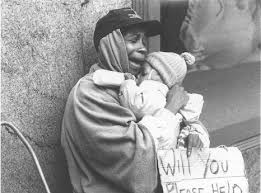Getting the facts
(continued)

How many children in America live in poverty?
According to the federal government, 14 million childrenin the United States officially live in poverty. That's 19 percent of all children, and what's worse, that number has been on the rise. There are2.5 million more childrenliving in poverty in America now than in 2000.
And that's only those who technically live in poverty — at or under the U.S. poverty line, which is $22,050 for a family of four. But a study from the Economic Policy Institute showsthat families need more than twice that, at least $48,778, to meet basic living expenses. When we take into account all the families who are struggling to meet these basic needs — defined as low-income families — the number poor children jumps to 29 million, or 41 percent of all American children.
The poverty rate is higher for children than any other age group. Children make up 26 percent of the population, but they are 39 percent of the people who live in poverty. Every day, 2,660 childrenare born into poverty.
While many still think of homeless people as single adult men, children and families are actually the fastest growing group among the homeless, making up 40 percent of the homeless population. One in 50 childrenin the U.S. is currently homeless.

Where is child poverty the worst?
Mississippi and the District of Columbia have the highest rates of child poverty, both over 25 percent. Fifteen other states (Alaska, Arizona, Arkansas, Georgia, Kentucky, Louisiana, Missouri, New Mexico, North Carolina, New York, Ohio, Oklahoma, Tennessee, Texas and West Virginia) have child poverty rates above 20 percent. New Hampshire has the best child poverty record, with just seven percent of that state's children living in poverty.
The South is the worst region for child poverty(pdf), with 42 percent of Southern children living in low-income families. The Midwest has the lowest rate,35 percent.
The highest rates of child poverty aren't actually in urban or inner city neighborhoods, but in rural areas, where 47 percent of kids have low-income families. In urban areas, that rate is 40 percent, while the suburbs have only 30 percent.

How does race affect child poverty?
Race is a huge factor in whether or not a child will grow up poor. The poverty rate for white childrenis 11 percent. For black children, it's more than three times that, at 34 percent. Hispanic children suffer at similar levels, with 31 percent growing up in poverty. Native American children also experience poverty rates of 31 percent. Thirteen percent of Asian children live in poverty. When you consider not just children living under the poverty line, but also low-income children, 61 percent of black and Hispanic kidslive in families that struggle to make ends meet.


Who are their parents?
The majority of children living in poor or low-income families — 55 percent — have a parent who works full time, year around. Twenty-six percent of their parents work part time. But another 20 percent do not have a parent who has a job.
Many poor and low-income families are headed by a single mom (51 percent), but 36 percent of these families have married parents, defying the stereotype that only single parent families are poor.
Immigrant families deal with much higher rates of child poverty. More than one in fivechildren born to immigrant families are poor, while just 14 percent of native-born children are.
Their parent's education levelsare varied. Thirty-six percent have a high school diploma, but 26 percent, or 7.3 million parents, have less than a high school education. Nearly 40 percent have completed at least some college.
Too often, the poor are blamed for their situation. People say they must be lazy, stupid or ignorant, unwilling to work or get an education. But what we fail to see is that the majority of people we're talking about are children, born into poverty through no fault of their own, yet gripped by it. We must rally together to give these children the American dream — that no matter who you are when you're born, you have the opportunity to succeed.
